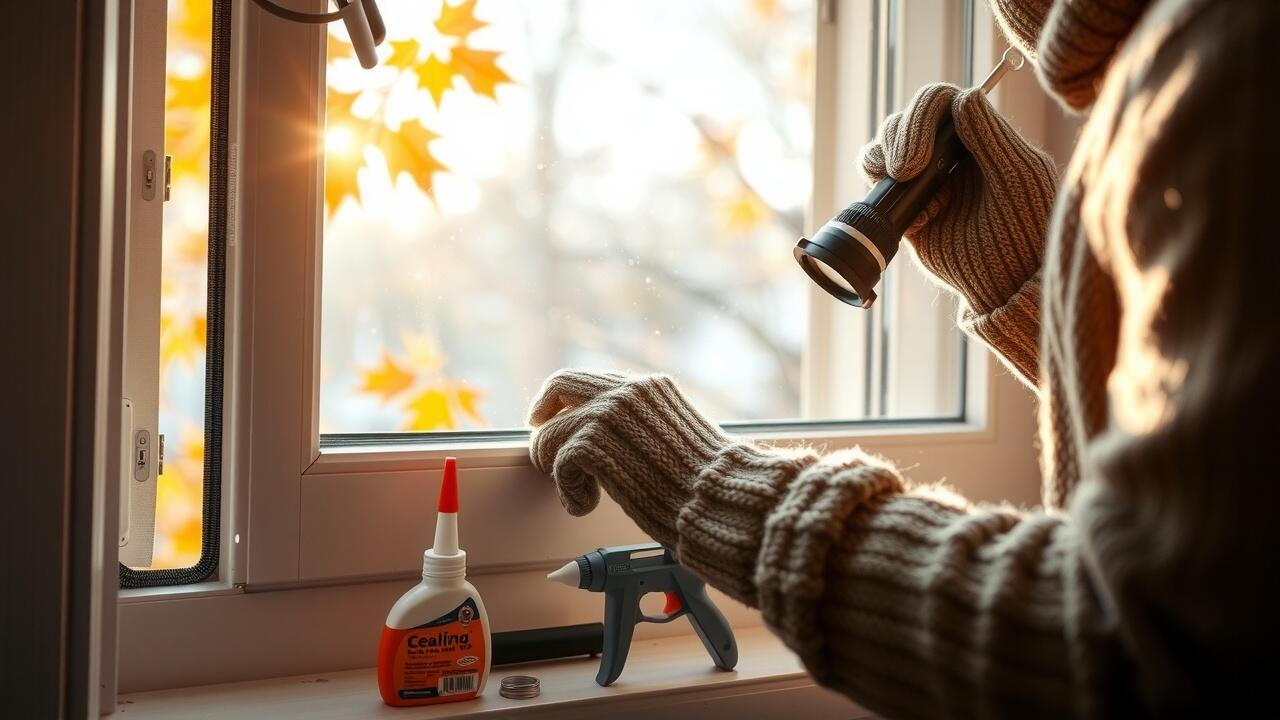Key Takeaways
- Importance of checking and securing windows prior to the colder season
- Procedures for examining window conditions
- Choices available for sealing windows
- Techniques for applying caulk and sealing windows for winter readiness
Inspect And Seal Windows Before Winter | Importance of Preparing Windows for Winter
Preparing your home for the harsh winters begins with the crucial task of inspecting and sealing windows before winter. A thorough inspection ensures that window frames, sashes, and seals are intact, preventing cold drafts from infiltrating your living space. Proper window insulation, including the use of window films and sealant, can significantly enhance energy efficiency, keeping your home warm while reducing heating costs. Neglecting these steps can lead to cold spots and increased energy bills. Curtains, blinds, and even pet doors should also be checked for their ability to keep warmth in. Taking these measures will ensure that your windows provide the protection and comfort needed during the chilly months ahead.
inspect and seal windows before winter | Benefits of Inspecting Windows
Preparing your home by inspecting and sealing windows before winter brings significant benefits. This process helps ensure that heating and cooling systems operate efficiently, reducing energy costs during the colder months. By examining double-hung windows and doors for leaks, homeowners can prevent drafts that lead to uncomfortable indoor temperatures. Sealing these areas contributes to better insulation, which is essential for maintaining warmth and comfort, especially near ceilings and the fireplace.
Addressing potential issues with insulated glass before snow falls can prevent costly repairs later. Sealing windows effectively reduces the strain on heating systems, aiding in better temperature regulation throughout the home. A well-sealed space not only enhances energy efficiency but also allows window treatments to work more effectively, creating a cozy atmosphere during winter. Taking the time to inspect and seal windows before winter ultimately leads to a more comfortable home environment all season long.
| Benefit | Description | Impact |
|---|---|---|
| Improved Energy Efficiency | Sealing windows helps maintain indoor temperatures by minimizing heat loss. | Lower energy bills during winter months. |
| Enhanced Comfort | Prevents drafts and cold spots, ensuring a uniform temperature indoors. | A more pleasant living environment throughout the winter. |
| Cost Savings | Addressing leaks and insulation issues early can save on repair costs down the line. | Reduces future maintenance expenses related to heating systems. |
| Efficient Use of Window Treatments | Well-sealed windows improve the effectiveness of curtains and blinds. | Creates a cozier atmosphere by enhancing heat retention. |
Potential Issues from Neglected Windows
Neglected windows can lead to significant issues during the winter months. Failing to inspect and seal windows before winter allows cold air to infiltrate your home, leading to drafts and inconsistent indoor temperatures. Inadequate weatherization can cause your heating system to work overtime, resulting in higher energy bills. Without proper weatherstripping and a functional window seal, air leaks can compromise the comfort of your living space, making it crucial to address these problems proactively.
Ignoring a winter window check can also cause damage to your walls and window frames. Moisture from outside can seep through gaps, leading to mold growth and potential structural issues. In harsh climates, the fluctuation of temperature can exacerbate these effects, causing materials to expand and contract, which further deteriorates seals. Effective window sealing helps maintain proper ventilation while keeping the elements at bay, making it vital to seal leaks and ensure your home is winter-ready.
Steps to Inspect Windows
Preparing to inspect and seal windows before winter involves a comprehensive approach to ensure proper window weatherization. Homeowners should closely inspect these areas for any gaps or damage, paying particular attention to the window coverings and the window material. Using door installation sealant can help achieve a secure seal, while ensuring that the final seal is airtight. It’s essential to seal air leaks to maintain energy efficiency and comfort during colder months. A clear window insulation can also enhance the effectiveness of your efforts. By following these steps and sealing any gaps with appropriate materials, you will create a weather-tight seal that protects your home from winter’s harsh conditions.

How to Check for Drafts
Drafts can significantly impact indoor comfort during the cold winter months. To prevent this, it is essential to inspect and seal windows before winter. Begin by checking for any gaps around the window frames where cold air might enter. Pay particular attention to old windows, as their seals can deteriorate over time. Spring v-seals can be an effective solution. If you notice any areas where the sealant has failed, they may require a draft-proof seal using the right sealant to ensure optimal insulation.
Another effective method for checking drafts involves the use of a candle or incense stick. Move the flame near the edges of the window while observing any flickering, which indicates air movement. This simple technique can highlight issues stemming from neglecting window inspections. If your windows have storm windows, ensure they are properly installed and functioning to enhance energy efficiency. Identifying these drafts early allows for timely measures to seal windows, keeping your home cozy throughout the cold winter.
Identifying Damaged Seals and Frames
A thorough inspection of your windows is crucial as winter approaches. Look for any signs of damage in the seals and frames. A brittle sealant can lead to significant drafts, compromising the effectiveness of your insulating windows. Ensure you inspect and seal windows before winter to maintain a tight seal that helps prevent heat loss. Well-maintained windows contribute to overall home energy efficiency and comfort, making winterization easier and more effective.
Damaged seals can often be found around exterior doors and windows, which is where air sealing becomes vital. If you notice any gaps or warping in the frames, this could indicate that the tension seal has failed. Utilizing tools like thermal curtains can enhance insulation alongside proper sealing efforts. Addressing these issues promptly through door weatherization and other sealing methods will keep your home warm and reduce energy costs throughout the cold months.
Sealing Options for Windows
Preparing to winterize your home involves understanding various sealing options for your windows. To effectively insulate windows, homeowners should inspect and seal windows before winter, ensuring that all movable window parts are functioning optimally. Bottom seals and weatherstrip doors play crucial roles in blocking drafts as cold outside air infiltrates through gaps. As winter weather approaches, it is essential to consider installing window insulation and possibly opting for window replacement if the damage is extensive. Wide windows may require extra attention, with proper sealing being key to maintaining warmth indoors. Utilizing thermal drapes can enhance insulation, providing an additional layer of protection when winter arrives.

Choosing the Right Caulk
Selecting the appropriate caulk is crucial for those planning to inspect and seal windows before winter. For optimal results, consider using a high-quality, flexible caulk specifically designed for windows and doors. Products formulated for exterior applications will effectively adhere to various sealing materials, ensuring a tight barrier against the cold. Properly applied caulk around window panes and exterior door bottoms can significantly reduce drafts, preventing cold spots and maintaining a comfortable indoor environment during the winter months.
Consulting with a local window professional can provide valuable insights into the best caulking options for your specific needs. It’s essential to ensure that the chosen caulk works well with tension seals and can withstand temperature fluctuations. A preliminary inspection of your windows will help identify areas requiring attention. Sealing gaps with the right caulk not only enhances energy efficiency but also protects your home from the elements, reducing the need for seasonal curtains to block a cold breeze.
Best Practices for Sealing Windows
To effectively prepare your home for the cold months, it is essential to inspect and seal windows before winter. A thorough inspection helps identify areas where cold air may seep through, particularly around insulated glass panels. Utilize effective air-sealing techniques to ensure a tight seal between the windows and the exterior walls. This will prevent harsh winter elements from infiltrating your living space, ultimately reducing energy costs during winter temps. If you find that your windows are beyond repair, consider window replacements as a viable option.
Best practices also include checking the condition of your exterior siding to ensure there are no gaps where cold air can enter. Pay special attention to any new Pella windows, as they often come with advanced sealing features that enhance energy efficiency. Choose doors that complement your windows and provide a consistent barrier against cold weather. Regular annual winterization efforts are crucial in maintaining the integrity of your home’s insulation, so make sealing windows a priority in your winter preparation checklist.
How to Caulk and Seal Windows for Winter
Preparing to inspect and seal windows before winter is essential to ensure energy efficiency and comfort. The process begins with removing any window treatments, such as honeycomb blinds or drapes, which can block access to the frames. Once cleared, use a glass cleaner to maintain visibility while checking for drafts around window wells and door frames. Pay close attention to single-pane windows, as they can be particularly vulnerable to cold weather kicks and icy conditions. Implementing a seasonal window insulator can further enhance your winter-prep efforts, keeping your home warm while effectively sealing any openings. Ensuring that all potential issues are addressed ahead of the snowy months will save you from costly repairs later on.
- Inspect all window frames for gaps or cracks that need sealing.
- Choose the right type of caulk for your window materials (e.g., silicone for flexibility, acrylic for paintability).
- Clean the surfaces where you will apply caulk, ensuring they are free of dirt and old caulk.
- Apply caulk using a caulking gun, filling gaps evenly and smoothly.
- Tool the caulk surface with a wet finger or a caulking tool for a neat finish.
- Allow the caulk to cure as per manufacturer instructions before replacing window treatments.
- Consider adding weather stripping for an extra layer of insulation.
Tools and Materials Needed
Preparing to inspect and seal windows before winter requires specific tools and materials. A thermal leak detector can help pinpoint areas where icy drafts penetrate, ensuring a thorough inspection. Having the right caulk is essential, especially if you are dealing with low-emissivity windows or undressed windows. For doors, selecting door sweeps can effectively block any gaps that may allow cold air to enter. Ensuring the window frame is devoid of any dust, dirt, or moisture ensures a better seal and helps maintain energy efficiency.
Gathering supplies such as caulk guns, putty knives, and painter’s tape will streamline your sealing process. Inspecting locks and ensuring they function properly can also prevent unwanted airflow. Proper window treatments, like insulated curtains, add another layer of protection against winter’s chill. By preparing these tools and materials, homeowners can effectively tackle the task of inspecting and sealing windows before winter and avoid the pitfalls of overlooking critical areas during cold months.
Step-by-Step Caulking Process
A thorough inspection is essential before you begin to inspect and seal windows before winter. Start by cleaning the window frames and removing any screens. This step ensures a clear view of any issues that need attention. As you assess the condition of the windows, check for gaps that could allow cold drafts to enter. It is crucial to maintain a tight seal to keep your home warm during the colder months. If you notice drafty windows, you may want to apply special coatings or consider new drapes as additional layers of insulation.
Once the inspection is complete, the sealing process can begin. Choose a high-quality caulk suitable for both operable windows and stationary frames. Apply the caulk carefully to fill in any gaps you identified during your inspection. Allow the caulk to cure properly before the cold temps set in. This approach will help you cover any potential leaks, ensuring that the interior temperature remains comfortable even during extreme weather conditions. By taking these steps, you will effectively reduce heat loss and enhance the overall efficiency of your home.
Conclusion
Inspecting and sealing windows before winter is critical for maintaining a comfortable indoor temperature during the colder months. This process helps identify air leaks and openings that could allow the biting cold to infiltrate your home. Utilizing energy-efficient doors and ensuring the proper installation of door sweeps can enhance your home’s insulation, reducing cooling usage and heating costs. It’s also essential to check the fireplace flue to prevent unwanted drafts. For those who may not feel confident in their DIY skills, professional weatherization services can provide expertise in sealing leaks effectively. Taking these steps to inspect and seal windows before winter not only enhances comfort but also contributes to overall energy efficiency.
FAQS
How can I effectively caulk and seal windows for winter to achieve winter-ready windows?
To caulk and seal windows for winter and ensure they are winter-ready windows, first, inspect these areas and seal any gaps with appropriate materials. This may involve using window insulation film or replacing any old or failing sealants, ensuring that the window frame must be devoid of any dust, dirt, or moisture. Properly sealing your windows will minimize heat loss and contribute to efficient window sealing, helping to keep your home cold during the winter months. Additionally, consider using low-emissivity windows or installing window insulation to enhance insulation.
What steps should I take to inspect and seal windows for winter to ensure they are ready for the cold season?
To effectively caulk and seal windows for winter, start by inspecting your windows section for any signs of wear, focusing on the window sash and areas where sealant failures may occur. Clean and remove screens, then apply an airtight seal with an appropriate sealant. Consider installing window insulation such as low-emissivity windows or board insulation. To further weatherize your home, check if your doors are tight and inspect heating efficiency. Additionally, consider the right window treatments like drapes to block cold air and maintain warmth in a warm climate, making sure you’re prepared for the cold season with insulated windows.
What methods can I use to effectively caulk and seal windows for winter to ensure they are prepared for harsh weather conditions?
To effectively caulk and seal windows for winter, start by inspecting, cleaning, and removing screens from the windows. Check for any possible seal issues and use an appropriate sealant to fill gaps. You may also want to install window insulation or consider replacement window options such as low-emissivity windows or star-certified windows. Additionally, ensure that all doors are tight and consider using drapes to block drafts for optimal weatherizing of your home.
What tips can I follow to properly caulk and seal windows for winter to make sure my home is well-prepared for the season?
To caulk and seal windows for winter effectively, start by inspecting your windows for any drafts or gaps. Clean the window frames and remove screens to ensure the sealant adheres properly. Choose an appropriate sealant that is designed for window applications. Once sealed, make sure that your window operating mechanisms are functioning smoothly, and check that drapes block any cold air from entering. If you have low-emissivity windows, they can also enhance energy efficiency alongside well-sealed doors.
What materials do I need to caulk and seal windows for winter effectively?
To effectively caulk and seal windows for winter, first, you’ll need an appropriate sealant that suits your window type. Additionally, ensure to inspect, clean, and remove screens before applying the caulking. If applicable, select doors that complement low-emissivity windows to enhance energy efficiency and maintain a door tight fit against cold drafts.
What are the best practices to caulk and seal windows for winter to ensure maximum insulation?
To caulk and seal windows for winter effectively, use a sealant appropriate for the conditions, such as one designed for low-emissivity windows that helps reduce heat loss. Be sure to check for gaps and apply caulk evenly around the frames for optimal insulation.
How do low-emissivity windows impact the process to caulk and seal windows for winter?
Low-emissivity windows are designed to reflect heat back into your home, making them more energy-efficient. When you caulk and seal windows for winter, it’s important to ensure that these windows are properly sealed to maximize their efficiency and minimize heat loss. This will enhance the insulation and performance of your low-emissivity windows during the cold months.
How do low-emissivity windows change the approach to caulk and seal windows for winter?
Low-emissivity windows can reduce the need to caulk and seal windows for winter as they are designed to minimize heat transfer. However, proper sealing is still important to maintain energy efficiency and prevent drafts, so you should ensure that even these windows are adequately caulked and sealed for winter conditions.
How do I adjust my technique to caulk and seal windows for winter if I have low-emissivity windows?
If you have low-emissivity windows, it’s important to consider their energy-efficient properties when you caulk and seal windows for winter. Ensure that you use the appropriate weatherstripping and caulk to maintain their efficiency, as the coatings on these windows can affect adhesion.
How should I caulk and seal windows for winter if my home has low-emissivity windows?
When you need to caulk and seal windows for winter in a home with low-emissivity windows, it’s important to use a flexible, high-quality caulk that adheres well to the unique coatings on low-emissivity windows. Make sure to inspect any gaps thoroughly and apply the caulk in a manner that allows for expansion and contraction due to temperature changes, ensuring a tight seal against the cold.
